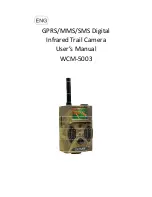
Spyder 3 GigE User’s Manual
DALSA 03-032-10158-09
71
Calibrating the Camera to Remove Non-Uniformity
(Flat Field Correction)
Flat Field Correction Overview
Note: The QuickCam software that ships with the Spyder 3 GigE camera has a flat field correction
wizard. For easy flat field correction, use the wizard located on the Calibration tab.
This camera has the ability to calculate correction coefficients in order to remove non-
uniformity in the image. This video correction operates on a pixel-by-pixel basis and
implements a two point correction for each pixel. This correction can reduce or eliminate
image distortion caused by the following factors:
•
Fixed Pattern Noise (FPN)
•
Photo Response Non Uniformity (PRNU)
•
Lens and light source non-uniformity
Correction is implemented such that for each pixel:
V
output
=[(V
input
- FPN( pixel ) - digital offset) * PRNU(pixel) – Background Subtract] x System Gain
where V
output
=
digital output pixel value
V
input
=
digital input pixel value from the CCD
PRNU( pixel)
=
PRNU correction coefficient for this pixel
FPN( pixel )
=
FPN correction coefficient for this pixel
Background Subtract
=
background subtract value
System Gain
=
digital gain value
The algorithm is performed in two steps. The fixed offset (FPN) is determined first by
performing a calibration without any light. This calibration determines exactly how much
offset to subtract per pixel in order to obtain flat output when the CCD is not exposed.
The white light calibration is performed next to determine the multiplication factors
required to bring each pixel to the required value (target) for flat, white output. Video
output is set slightly above the brightest pixel (depending on offset subtracted).
Flat Field Correction Restrictions
It is important to do the FPN correction first. Results of the FPN correction are used in the
PRNU procedure. We recommend that you repeat the correction when a temperature
change greater than 10°C occurs or if you change the analog gain, integration time, or line
rate.
PRNU correction requires a clean, white reference. The quality of this reference is
important for proper calibration. White paper is often not sufficient because the grain in
the white paper will distort the correction. White plastic or white ceramic will lead to
better balancing.
Note: If your
illumination or white
reference does not
extend the full field of
view of the camera,
the camera will send a
warning.
Содержание Spyder 3 GigE SG-10-01k80-00-R
Страница 17: ...Spyder 3 GigE User s Manual DALSA 03 032 10158 09 17 ...
Страница 37: ...Spyder 3 GigE User s Manual DALSA 03 032 10158 09 37 ...
Страница 43: ...Spyder 3 GigE User s Manual DALSA 03 032 10158 09 43 ...
Страница 47: ...Spyder 3 GigE User s Manual DALSA 03 032 10158 09 47 ...
Страница 115: ...Spyder 3 GigE User s Manual DALSA 03 032 10158 09 115 ...
















































